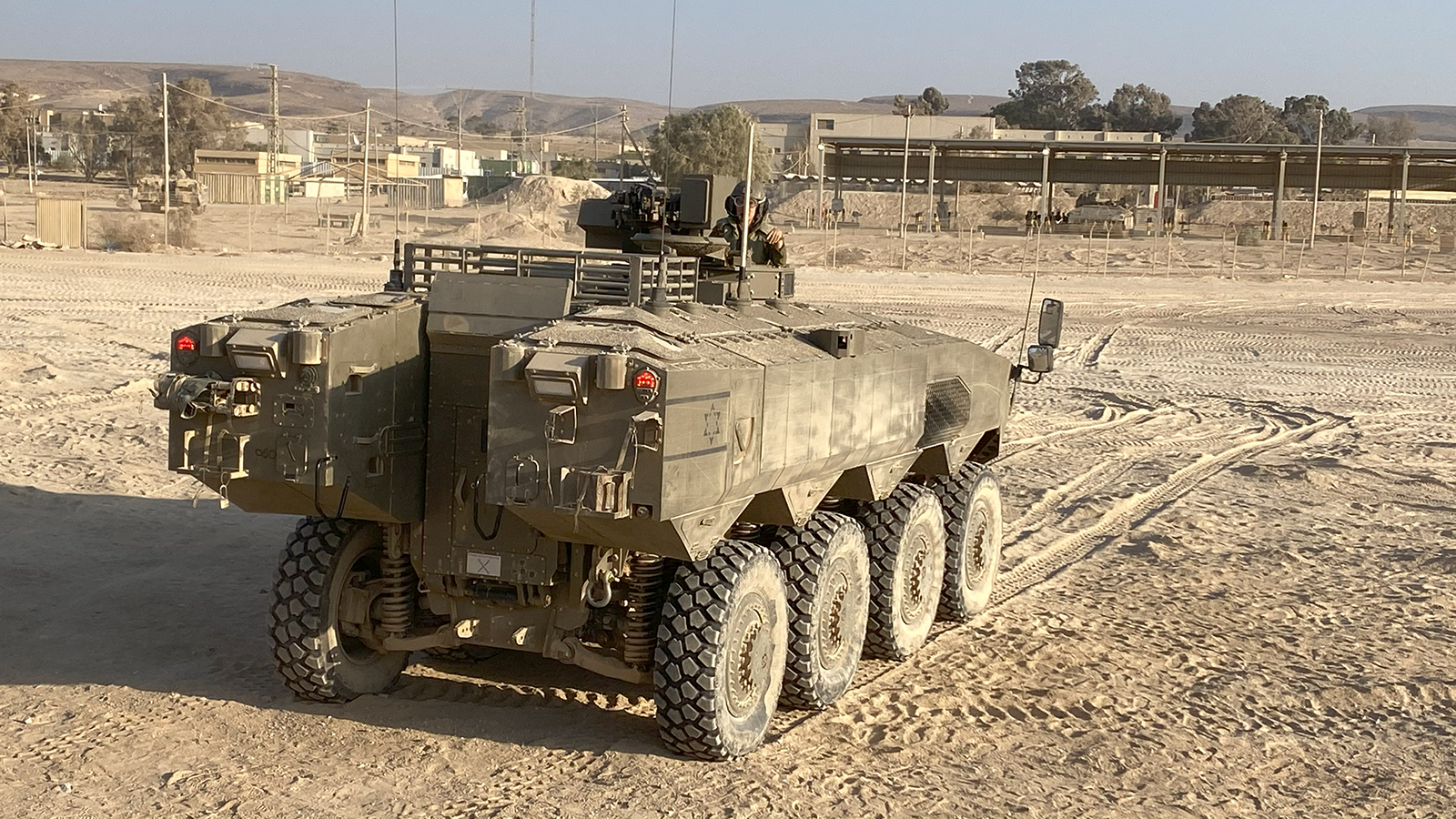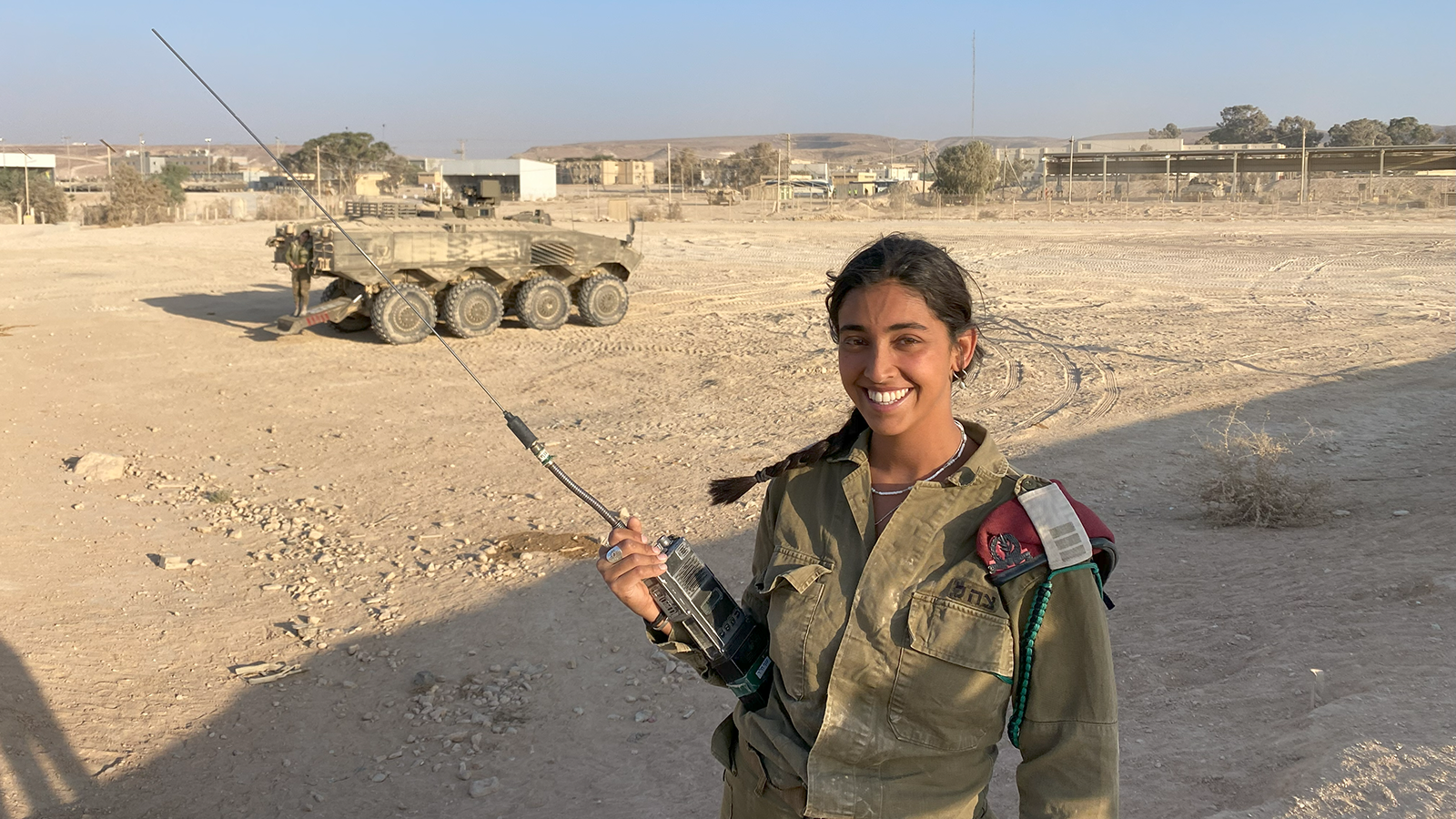SETH J. FRANTZMAN

SOUTHERN ISRAEL — Israeli Defense Forces Capt. Yuval Levy knows a lot about armored personnel carriers (APCs). Over the last several years she has trained soldiers on the older Israeli M113s, the 60-ton Namer that entered service in 2008, and now on the latest Israeli APC, the wheeled Eitan, which began deployments just this year.
To Levy, the Eitan represents a Goldilocks capability: more protected than the M113 but more agile than the ponderous Namer.
“The Eitan APC is less heavy than the Namer. Because it is less heavy it can go faster and it can traverse mountainous terrain such as in an environment like the Golan. It has more abilities. The eight wheels are more versatile than a tank because they are higher,” Levy said. Meanwhile, Levy joking compared the M113 to a “taxi to the battlefield” due to its relatively light armor.

Capt. Yuval Levy, the training commander for the Eitan, standing on a dune in Israel’s southern Negev desert at an urban warfare training facility, the Eitan APC behind her.
Levy spoke to Breaking Defense during an exclusive tour of the training base in southern Israel where the first crews are learning to use the Eitan as it is deployed with the IDF’s Nahal brigade. Levy trains soldiers who will go on to perform various roles in the new vehicle, such as the driver, gunner and commander. Crews have been going through the training for eight months as part of staggered courses of between six and nine weeks. Most of the trainers are female soldiers, though the APC will likely mostly be used by male soldiers in combat roles.
The Eitan sits on eight wheels, similar to other wheeled fighting vehicles, such as the Stryker, the Boxer, the French VBCI and the Russian BTR. But for Israel the introduction of the vehicle signaled a major shift from the use of aging M113s and the tracked Namer, which is based on a Merkava tank chassis. The Eitan is expected to be augmented with Israel’s latest defense technology, such as the Iron Fist active protection system, part of a broader modernization push by the IDF that also includes new loitering munitions and a new version of the Merkava tank.
Comparing the APC to other modern carriers, Levy said the vehicle “is more safe, more armored, and the systems are more advanced.” It’s also relatively fast, with a top speed of 90 kilometers per hour (56 miles per hour).
The first units to train on the new APC were from the 50th Battalion’s Sayeret Nahal, an elite unit within the brigade. It will then be rolled out to the rest of the 50th and the brigades other three battalions.
During the tour, the trainers drove the APC around an urban warfare training base. The large tires churned up dust as the vehicle made its way through sand dunes and onto a dirt road. The urban warfare area consisted of a number of small buildings that are supposed to represent single and multiple story houses. The same facility is used to train soldiers with the IDF’s new Firefly loitering munition, showing how the IDF is integrating new technology for the infantry at the same training facility.
The trainers also provided a tour inside the vehicle, showing how it has been designed to provide not only comfort and space for soldiers who might spend many hours or days inside, but also how it is set up for the driver and commander; with a viewing area that enables the commander to peer out from the roof of the vehicle but still be protected, similar to a kind of cockpit.
The trainers say the vehicle has been filled with some of the latest technology, such as a screen that can flip down for the gunner, and other aspects of the IDF’s drive for more networked digitization. The vehicle has thermal optics and sensors for use at night and in dust and other situations of limited visibility.
The Eitan can hold 12 soldiers, including the driver, commander and gunner. That means nine soldiers that can exit the vehicle in a combat zone, through a ramp in the back. The gunner can operate two weapon stations that can mount an FN MAG .50 machine gun and another weapon system. When Breaking Defense visited the training site in early September, the vehicle had still not seen operational combat.
The Israeli defense firm Elbit Systems said that its Iron Fist protection system will be integrated on the Eitan by the beginning of next year. The Namer and D-9 bulldozer will also get “more or less” identical Iron Fist systems, the company said.
The Iron Fist is characterized by inclusion of several elements or “Line Replaceable Units,” meaning it usually is installed with two launchers and four sensors that are linked to radar and electro-optics. The system is then linked with two launcher control units and a main computer that includes the system’s algorithms and its threat library, an unnamed Elbit official said in a company statement.
“The uniqueness of Iron Fist is that it is designed to defeat the full threat spectrum of anti-tank munitions from RPGs, ATGMs [anti-tank guided missiles], UAS [unmanned aerial systems] and up to tank kinetic energy rounds,” Elbit said. Elbit characterizes it as having a number of features, including open architecture, minimal collateral damage and being designed to stop salvos of incoming threats simultaneously on both sides of a platform.
The company also says it has a good “SWAP” or size, weight and power. This is important because of all the different add-ons to armored vehicles, having a low size and weight compared to the power necessary to address threats makes a system more flexible.
No comments:
Post a Comment